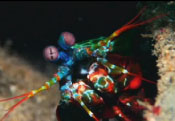 |
NASA | GSFC | JPL | Site Map |
|
|
 |
 |
Education: Student Outcomes |
Click here to search for other assets Keeping Up With Carbon: Ocean Ecosystem Impacts of Climate Change Grade level: 9-12 Themes: climate, water cycle Video: keeping_up_carbon_04.flv
Stacey Boland: "As the ocean absorbs more carbon dioxide, it becomes more acidic, and this can be a threat to some of the organisms that live inside the ocean." As Earth's climate continues to change, how will researchers monitor something as big as the ocean, and something as complex as the carbon cycle? NASA Earth observing satellites give scientists the "big picture" view of our home planet. Varied satellites help researchers detect changes in ocean climate and ecology over time, providing vital insight into the health of our home planet. (source) Student Outcomes After viewing this video, students should be able to: Explain how climate variations can induce changes in the global ocean circulation. (C: 9-12) Determine if global precipitation, evaporation, and the cycling of water are changing. (W: 9-12) Key: C = climate / O = ocean circulation / T = 21st century technology / W = water cycle |
|||||
